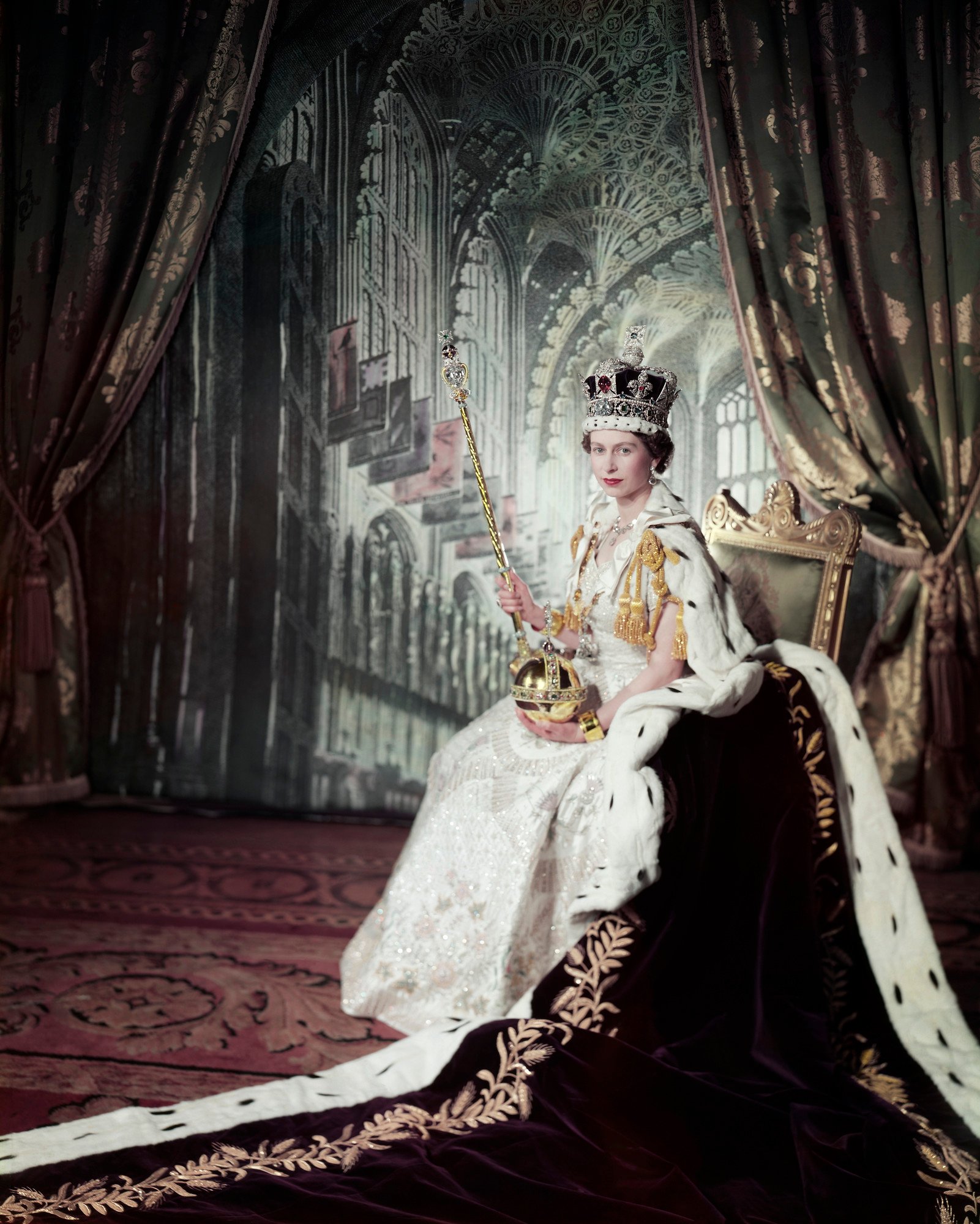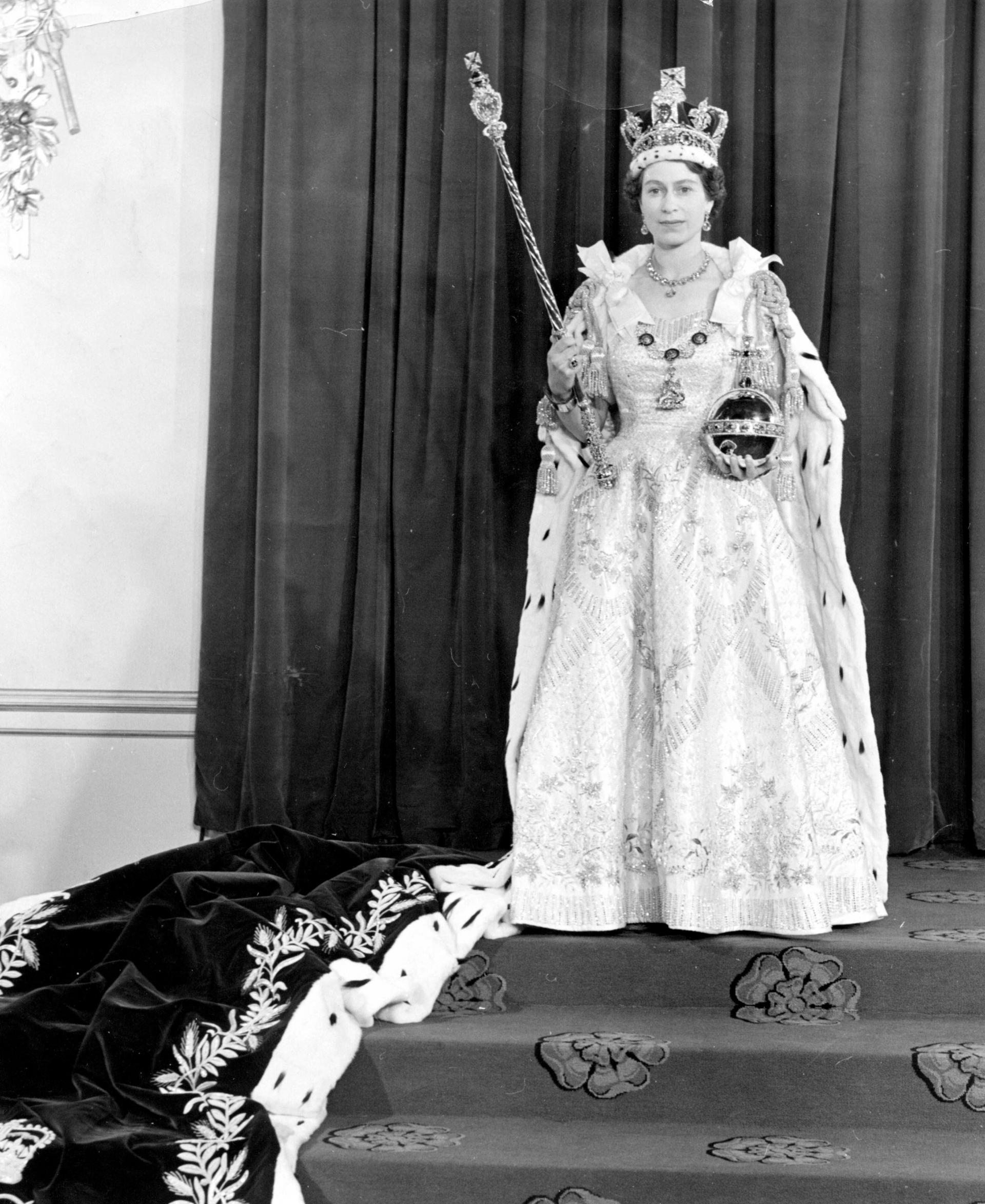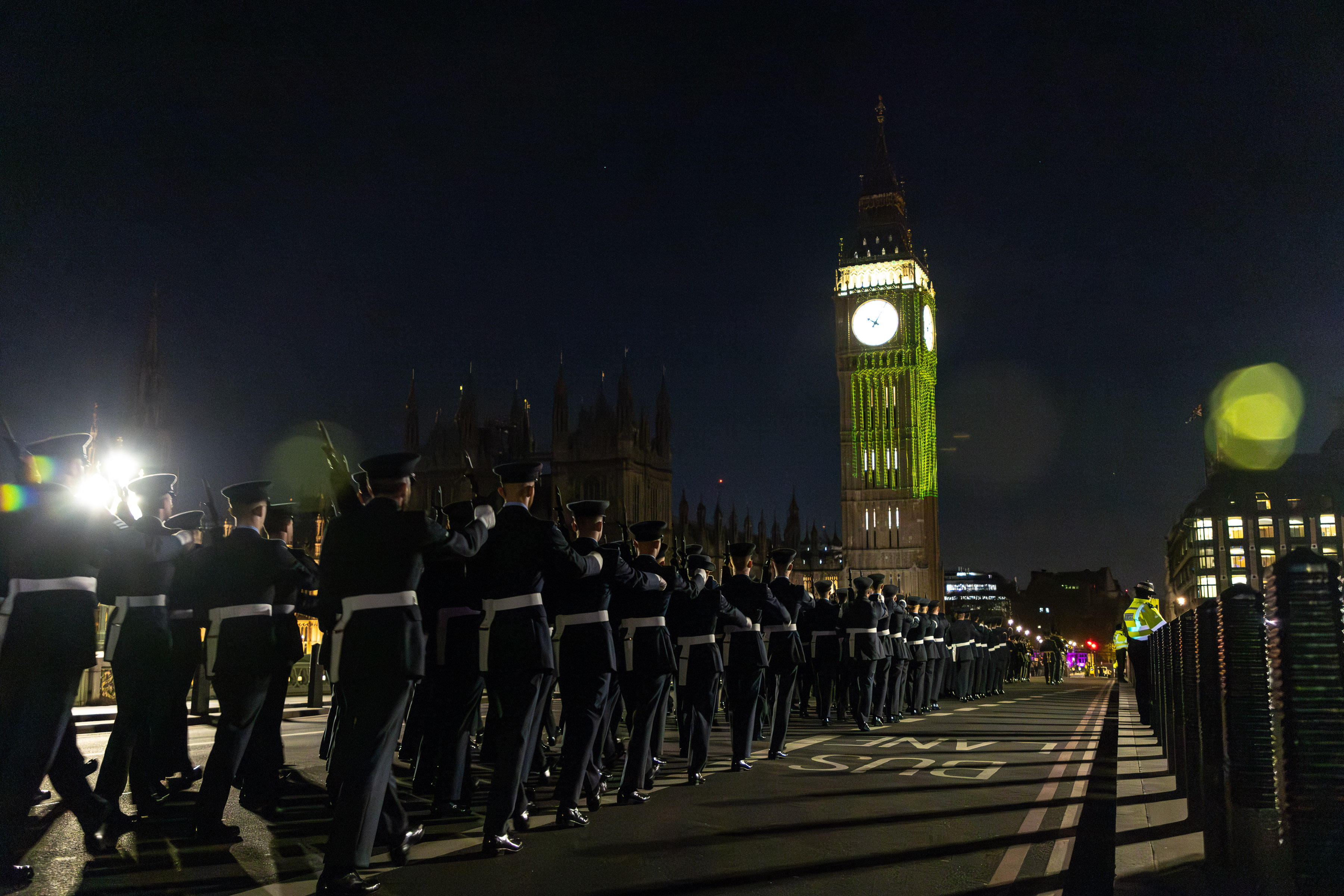|
Supertunica
A Supertunica is a robe worn by British monarchs at their coronation. It is donned shortly after the Anointing ceremony for the vesting of the Crown_Jewels_of_the_United_Kingdom#Spurs, Spurs, Crown_Jewels_of_the_United_Kingdom#Swords, Sword of Offering and the Crown_Jewels_of_the_United_Kingdom#Armills, Armills. Afterwards the Stole Royal and Robe Royal are worn on top of the Supertunica for the crowning of the monarch. The Supertunica, Stole and Robe are replaced with the Imperial Robe for the final procession from Westminster Abbey. Use The monarch enters Westminster Abbey for their coronation wearing the Robe of State. This is removed for the Anointing ceremony in which they wear the ''Colobium sindonis'' ("shroud tunic"), an intentionally plain robe. After the Anointing the monarch dons the more ornate Supertunica over the ''Colobium''. It is worn whilst the monarch is invested with other regalia including the Crown_Jewels_of_the_United_Kingdom#Spurs, Spurs, Crown_Jewel ... [...More Info...] [...Related Items...] OR: [Wikipedia] [Google] [Baidu] |
Stole Royal
The Stole Royal (sometime erroneously called the ''Armilla'') is an item of regalia used during the coronation of a British monarch, similar to the stole (vestment), stoles worn as vestments by clergymen. It is donned after the anointing of the monarch and is worn throughout the crowning, receiving of homage and conclusion of the communion. The Stole Royal is removed, with other garments, before the procession from Westminster Abbey for which the Imperial Robe is worn. Use The monarch enters Westminster Abbey for their coronation wearing the Robe of State. This is removed for the anointing ceremony in which they wear the ('shroud tunic'), an intentionally plain robe. After the anointing the monarch dons the more ornate Supertunica over the . After they have been invested with regalia including the Crown Jewels of the United Kingdom#Spurs, Spurs, Crown Jewels of the United Kingdom#Swords, Sword of Offering and the Crown Jewels of the United Kingdom#Armills, Armills the mo ... [...More Info...] [...Related Items...] OR: [Wikipedia] [Google] [Baidu] |
Robe Royal
The Robe Royal (also known as the ''Pallium Regale'', Imperial Mantle or Dalmatic Robe) is a robe worn by the British monarch when he or she is crowned. It is donned just before the monarch is invested with the Orb, Ring and Sceptres. It is worn during the crowning and paying of homage. The Robe Royal used is one originally created for the 1821 coronation of George IV. Use The monarch enters Westminster Abbey for their coronation wearing the Robe of State. This is removed for the Anointing ceremony in which they wear the '' Colobium sindonis'' ("shroud tunic"), an intentionally plain robe. After the Anointing the monarch dons the more ornate Supertunica over the ''Colobium''. After they have been invested with regalia including the Spurs, Sword of Offering and the Armills the monarch dons the Robe Royal over the top of the Supertunica and also wears the Stole Royal. The monarch is then invested with the Orb, Ring and Sceptres and crowned by the Archbishop of Canter ... [...More Info...] [...Related Items...] OR: [Wikipedia] [Google] [Baidu] |
Crown Jewels Of The United Kingdom
The Crown Jewels of the United Kingdom, originally the Crown Jewels of England, are a collection of royal ceremonial objects kept in the Jewel House at the Tower of London, which include the coronation regalia and vestments worn by British monarchs. The coronation regalia are the only working set in Europe and the collection is the most historically complete of any royal regalia in the world. Objects used at the coronation ceremony variously denote the monarch's roles as head of state of the United Kingdom, Supreme Governor of the Church of England, and head of the British armed forces. The regalia feature heraldic devices and national emblems of England, Scotland, Wales, Northern Ireland, and other Commonwealth countries. Use of regalia by monarchs in England can be traced back to when the country was converted to Christianity in the Early Middle Ages. A permanent set of coronation regalia, once belonging to Edward the Confessor, was established after he was made a saint in ... [...More Info...] [...Related Items...] OR: [Wikipedia] [Google] [Baidu] |
Imperial Robe
The Imperial Robe (also Robe of Estate or Imperial State Robe) is a robe used in the coronation of the British monarch. It is donned in the final stages of the ceremony for the procession of the monarch from Westminster Abbey to the waiting Gold State Coach. These Robes were last seen at the coronation of Charles III and Camilla, with King Charles III wearing the Imperial Robe of George V, and Queen Camilla having a new robe made for her. Use The robe is donned at the end of the coronation when, after being crowned and receiving homage the monarch proceeds to the shrine and tomb of Saint Edward the Confessor. Here the regalia are removed and the Robe Royal and Stole Royal taken off. The monarch is enrobed with the Imperial Robe and processes out of the Abbey whilst wearing the Imperial State Crown and carrying the Orb and Sceptre with Cross. During the coronation the monarch is enrobed by the lord great chamberlain who is assisted by the groom of the robes and the master of ... [...More Info...] [...Related Items...] OR: [Wikipedia] [Google] [Baidu] |
Robe Of State
The Robe of State (also known as the Parliament Robe) is a robe worn by the British monarch on state occasions. A monarch typically has a robe made for their coronation and reuses it when attending the State Opening of Parliament at the start of each legislative session. Traditionally the robes have an ermine cape with a long train made of crimson coloured velvet, trimmed in gold lace and lined with ermine. Use The Robe of State is worn by the monarch for their entrance into Westminster Abbey for their coronation. It is worn subsequently for the State Opening of Parliament and from this association derives its alternative name of Parliament Robe. Recent kings Edward VII, George V and George VI all wore the Cap of State in conjunction with the robe at their coronations but Charles III chose not to do so. The Robe of State remains in place during Recognition, Acclamation, the administering of the Coronation Oath and the first part of the service of Communion. The Robe of ... [...More Info...] [...Related Items...] OR: [Wikipedia] [Google] [Baidu] |
Coronation Of George VI And Elizabeth
The coronation of the British monarch, coronation of George VI and his wife, Queen Elizabeth The Queen Mother, Elizabeth, as King of the United Kingdom, king and List of British royal consorts, queen of the United Kingdom and Commonwealth realm, the Dominions of the Commonwealth of Nations, British Commonwealth, Emperor of India, Emperor and Empress of India took place at Westminster Abbey, London, on Wednesday 12 May 1937. George VI ascended the throne upon the Abdication of Edward VIII, abdication of his brother, Edward VIII, on 11 December 1936, three days before his 41st birthday. Edward's Abandoned coronation of Edward VIII, coronation had been planned for 12 May and it was decided to continue with his brother and sister-in-law's coronation on the same date. Although the music included a range of new anthems and the ceremony underwent some alterations to include the Dominions, it remained a largely conservative affair and closely followed the ceremonial of George V's coronat ... [...More Info...] [...Related Items...] OR: [Wikipedia] [Google] [Baidu] |
Regalia Of King James II First Plate (cropped To Supertunica) (cropped)
Regalia ( ) is the set of emblems, symbols, or paraphernalia indicative of royal status, as well as rights, prerogatives and privileges enjoyed by a sovereign, regardless of title. The word originally referred to the elaborate formal dress and accessories of a sovereign, but now it also refers to any type of elaborate formal dress. The word stems from the Latin substantivation of the adjective ''regalis'', "regal", itself from ''rex'', "king". It is sometimes used in the singular, ''regale''. In the abstract The term can refer to the rights, prerogatives, and privilege (legal ethics), privileges that are held exclusively by any sovereign, regardless of title (emperor, grand duke, etc.). An example of that is the right to mint (coin), mint coins, and especially coins that bear one's own effigy. In many cases, especially in feudal societies and generally weak sovereign state, states, such rights have in time been eroded by grants to, or usurpations by, lesser vassals. Royal ... [...More Info...] [...Related Items...] OR: [Wikipedia] [Google] [Baidu] |
Tabby Weave
Plain weave (also called tabby weave, linen weave or taffeta weave) is the most basic of three fundamental types of textile weaves (along with satin weave and twill). It is strong and hard-wearing, and is used for fashion and furnishing fabrics. Fabrics with a plain weave are generally strong, durable, and have a smooth surface. They are often used for a variety of applications, including clothing, home textiles, and industrial fabrics. In plain weave cloth, the warp and weft threads cross at right angles, aligned so they form a simple criss-cross pattern. Each weft thread crosses the warp threads by going over one, then under the next, and so on. The next weft thread goes under the warp threads that its neighbor went over, and vice versa. * Balanced plain weaves are fabrics in which the warp and weft are made of threads of the same weight (size) and the same number of ends per inch as picks per inch. * Basketweave is a variation of plain weave in which two or more thre ... [...More Info...] [...Related Items...] OR: [Wikipedia] [Google] [Baidu] |
Charles III
Charles III (Charles Philip Arthur George; born 14 November 1948) is King of the United Kingdom and the 14 other Commonwealth realms. Charles was born at Buckingham Palace during the reign of his maternal grandfather, King George VI, and became heir apparent when his mother, Queen Elizabeth II, acceded to the throne in 1952. He was created Prince of Wales in 1958 and Investiture of Charles, Prince of Wales, his investiture was held in 1969. He was educated at Cheam School and Gordonstoun, and later spent six months at the Timbertop campus of Geelong Grammar School in Victoria, Australia. After completing a history degree from the University of Cambridge, Charles served in the Royal Air Force and the Royal Navy from 1971 to 1976. In 1981, Wedding of Prince Charles and Lady Diana Spencer, he married Lady Diana Spencer. They had two sons, William, Prince of Wales, William and Prince Harry, Duke of Sussex, Harry. After years of estrangement, Charles and Diana divorced in 1996, ... [...More Info...] [...Related Items...] OR: [Wikipedia] [Google] [Baidu] |
Coronation Of Charles III And Camilla
The Coronation of the British monarch, coronation of Charles III and his wife, Queen Camilla, Camilla, as Monarchy of the United Kingdom, king and List of British royal consorts, queen of the United Kingdom and the 14 other Commonwealth realms, took place on Saturday, 6 May 2023 at Westminster Abbey. Charles Succession to the British throne, acceded to the throne on 8 September 2022 upon the Death and state funeral of Elizabeth II, death of his mother, Elizabeth II. It was the first coronation held since Coronation of Elizabeth II, that of Elizabeth II in 1953, nearly 70 years prior. The ceremony was structured around an Anglican service of Holy Communion. It included Charles taking an oath, being anointed with Holy anointing oil#In Christianity, holy oil, and receiving the Crown Jewels of the United Kingdom, coronation regalia, emphasising his spiritual role and secular responsibilities. Representatives of the Church of England and the British royal family d ... [...More Info...] [...Related Items...] OR: [Wikipedia] [Google] [Baidu] |
George IV
George IV (George Augustus Frederick; 12 August 1762 – 26 June 1830) was King of the United Kingdom of Great Britain and Ireland and King of Hanover from 29 January 1820 until his death in 1830. At the time of his accession to the throne, he was acting as prince regent for his father, King George III, having done so since 5 February 1811 during his father's final mental illness. George IV was the eldest child of King George III and Queen Charlotte. He led an extravagant lifestyle that contributed to the fashions of the Regency era. He was a patron of new forms of leisure, style and taste. He commissioned John Nash to build the Royal Pavilion in Brighton and remodel Buckingham Palace, and commissioned Jeffry Wyatville to rebuild Windsor Castle. George's charm and culture earned him the title "the first gentleman of England", but his dissolute way of life and poor relationships with his parents and his wife, Caroline of Brunswick, earned him the contempt of the peop ... [...More Info...] [...Related Items...] OR: [Wikipedia] [Google] [Baidu] |
Queen Victoria
Victoria (Alexandrina Victoria; 24 May 1819 – 22 January 1901) was Queen of the United Kingdom of Great Britain and Ireland from 20 June 1837 until Death and state funeral of Queen Victoria, her death in January 1901. Her reign of 63 years and 216 days, which was List of monarchs in Britain by length of reign, longer than those of any of her predecessors, constituted the Victorian era. It was a period of industrial, political, scientific, and military change within the United Kingdom of Great Britain and Ireland, United Kingdom, and was marked by a great expansion of the British Empire. In 1876, the British parliament voted to grant her the additional title of Empress of India. Victoria was the daughter of Prince Edward, Duke of Kent and Strathearn (the fourth son of King George III), and Princess Victoria of Saxe-Coburg-Saalfeld. After the deaths of her father and grandfather in 1820, she was Kensington System, raised under close supervision by her mother and her Comptrol ... [...More Info...] [...Related Items...] OR: [Wikipedia] [Google] [Baidu] |









